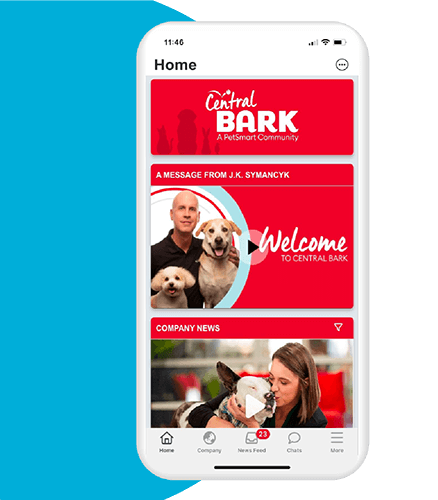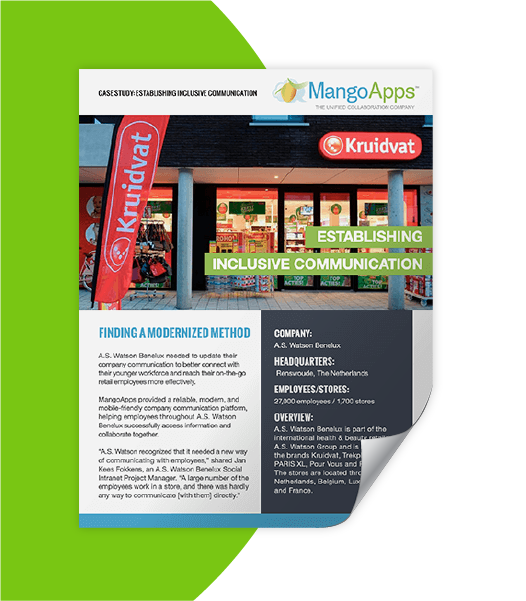In the bustling world of retail, the well-being of employees often takes a backseat. The pressures of consumer demand and sales targets can lead to stress, fatigue, and decreased job satisfaction. But it doesn’t have to be this way.
It’s crucial to acknowledge that frontline employees are not just cogs in the machine, but the beating heart of retail. Their well-being directly impacts quality of service, customer satisfaction, and ultimately, the company’s bottom line. Fostering well-being in retail isn’t just nice to have; it’s a strategic move that delivers tangible business benefits.
This article aims to shed light on the unique challenges of well-being in retail and offer strategies to address them. Our goal is to inspire retail chain administrators to prioritize employee well-being, creating a work environment that not only drives success but also fosters a positive and healthy culture. We hope this serves as a valuable guide, and encourage you to read more of our content or learn about our employee app for retail.
Understanding the Retail Landscape
The retail landscape is complex, with a myriad of factors influencing the well-being of those on the front lines. We will delve into the key aspects of the retail industry that directly and indirectly impact employee well-being. By building a comprehensive understanding of these factors, we can begin to formulate effective strategies for improving well-being in retail.
Current State of the Industry
The retail industry has always been dynamic, fast-paced, and customer-focused. The recent surge in online shopping and digital integration has only amplified these characteristics. From large chains to local boutiques, retailers are constantly adapting to meet the ever-changing needs and expectations of consumers.
One of the most pressing challenges in the industry is the increasing demands for an enhanced customer experience. Customers today expect seamless and personalized shopping experiences across all channels. This places pressure on retail employees, who must possess a wide range of skills and knowledge while also managing their own well-being.
The industry is also grappling with complex work schedules and the physical demands of retail work. Employees work weekends and holidays, and the work often involves long hours of standing, lifting, and handling different products. The resulting physical fatigue and stress can have a significant impact on the employee’s well-being and job satisfaction.

PetSmart Case Study
Learn how PetSmart has achieved 4x the industry standard for employee engagement with a mobile-first platform built on MangoApps.
The Advent of Online Shopping
Moreover, e-commerce and the shift towards omnichannel retailing has changed the job roles and responsibilities of retail employees. They are now expected to manage online orders, deal with queries on social media, and provide real-time customer service. This, combined with the traditional responsibilities of managing inventory and maintaining store aesthetics, can lead to job strain and burnout.
Despite these challenges, the retail industry also offers unique opportunities for employee well-being. Retail jobs often provide employees with a sense of purpose and the opportunity to connect with diverse groups of people. The industry also offers numerous career advancement opportunities. It’s possible for individuals to start in entry-level positions and work their way up to managerial roles. Understanding this balance between challenges and opportunities is vital for fostering well-being in retail.
Stressors and Challenges for Retail Employees
Retail employees face a multitude of stressors and challenges on a daily basis that can significantly impact their well-being. These range from dealing with difficult customers and managing high-pressure sales targets to coping with the physically demanding nature of the job and the lack of stable work schedules.
Interacting with Difficult Customers
One of the most common stressors in retail is dealing with difficult customers. Handling complaints, dealing with unreasonable demands, and managing conflicts can be mentally and emotionally draining. Over time, these negative experiences can lead to feelings of stress, frustration, and burnout.
Sales Pressure
Another significant challenge is the pressure to meet sales targets. Retail employees are often under constant pressure to sell more, upsell products, and meet the sales expectations of their employers. This pressure can lead to a high-stress work environment, which can negatively impact the overall well-being of employees.
Physical Demands and Unpredictable Work Schedules
The physical demands of retail work cannot be overlooked. Employees are often required to spend long hours on their feet, lift heavy goods, and handle a variety of products. Moreover, retail workers often have to deal with irregular and unpredictable work schedules, which can make it challenging to maintain a healthy work-life balance. This can lead to physical exhaustion, lack of rest, and can negatively impact mental health over time.
Job Insecurity and Low Wages
Retail jobs are often characterized by job insecurity and low wages. Many retail employees are hired on a part-time or temporary basis, and the industry is known for its high turnover rates. This job insecurity, coupled with often low wages, can lead to financial stress and anxiety.
Adapting to Technological Changes
With the advent of online shopping and digital technologies, retail employees are now required to adapt to new ways of doing business. This includes managing online orders, dealing with customer queries on social media, and using digital tools for tasks such as inventory management. For some employees, this technological shift can be challenging and stressful, especially for those who are not tech-savvy.
Understanding these challenges is the first step towards fostering well-being in retail. Corporate teams need to acknowledge the stressors that store employees face. Only then can you develop more effective strategies to support employees and create a more positive and healthy work environment.
Impact on Business
The impact of employee well-being on business outcomes in the retail sector is significant and multifaceted. A retail environment that promotes well-being can lead to increased employee engagement, improved customer service, and ultimately, better business performance.
Employee Engagement
A key element of well-being in retail is employee engagement, which is strongly correlated with job satisfaction, productivity, and loyalty. When retail employees feel valued, respected, and supported in their roles, they are more likely to be engaged in their work.
This engagement can lead to improved work performance, lower turnover rates, and greater commitment to the organization. In contrast, a lack of engagement can lead to decreased productivity, increased absenteeism, and higher turnover rates. All of these things can negatively impact a retailer’s bottom line.
Customer Service
The quality of customer service in the retail sector is heavily influenced by the well-being of retail employees. Employees who feel content and satisfied in their roles are more likely to provide excellent customer service, leading to increased customer satisfaction and loyalty. Positive interactions with staff can enhance the shopping experience, encouraging customers to return and potentially drive positive word-of-mouth referrals.
Conversely, employees who are dissatisfied, stressed, or burnt out are less likely to provide high-quality service, which may lead to negative customer experiences and potential loss of business.
Operational Efficiency
Employee well-being also impacts operational efficiency in retail. Retailers that prioritize employee well-being often experience lower employee turnover rates, resulting in fewer resources spent on recruiting, hiring, and training new employees. Healthy and happy employees are also more likely to be productive and efficient, leading to improved store operations and potentially higher sales.
To summarize, investing in employee well-being is not only ethically right, but it also makes good business sense. By prioritizing the health and happiness of retail employees, retailers can create a positive and engaging work environment that benefits both employees and customers, leading to enhanced business performance.
Key Areas for Well-being Focus in Retail
As we delve deeper into the subject of well-being in retail, it’s crucial to identify a few key areas that need special attention. These focal points are based on the unique challenges that retail employees face and the impact that employee well-being can have on the business outcomes. By addressing these areas, retail chain administrators can make a significant impact on overall well-being, leading to a more positive work environment and improved business performance.
Mental Health
Mental health is a crucial aspect of overall well-being, especially in the retail sector, which can be a high-stress environment. Retail employees often face a barrage of challenges, including demanding customers, high sales targets, unpredictable work schedules, and rapidly changing technologies, all of which can contribute to stress, anxiety, and even burnout. Therefore, it becomes essential for retail chains to cultivate a supportive work environment that prioritizes mental health.
Strategies to support mental health in retail might include providing mental health awareness training for all employees, fostering open communication about mental health issues, and offering access to mental health resources or employee assistance programs. Regular check-ins and surveys can also be useful to understand the mental health needs of employees and gauge the overall mood in the workplace. Furthermore, acknowledging and appreciating employees’ efforts can go a long way in mitigating work-related stress.
Retail administrators may also consider flexible work arrangements to accommodate the personal needs of employees, which can significantly reduce the stress associated with managing work-life balance. Moreover, incorporating regular breaks throughout the workday can allow employees to rest and recharge, reducing fatigue, and improving focus and productivity.
Lastly, promoting a culture of self-care and wellness among employees can go a long way in supporting mental health. This could include encouraging healthy habits like regular exercise, proper nutrition, and adequate sleep, all of which can have a profound impact on mental well-being.
In summary, addressing mental health in the retail sector requires a multi-faceted approach that acknowledges the unique challenges faced by retail employees. By focusing on mental health, retail chain administrators can significantly enhance overall well-being, leading to a more engaged, productive, and resilient workforce.
Physical Health
Physical health is another integral aspect of well-being in retail. The physical demands of retail work can vary significantly, from standing for long hours to heavy lifting. Without proper care and attention, such tasks can lead to physical strain, increased risk of injury, and longer-term health problems. Retail chains should, therefore, prioritize strategies that promote physical health among employees.
One of the key ways to ensure physical well-being is through ergonomic work environments. Ergonomically designed workstations, chairs, and equipment can significantly reduce physical strain and the risk of work-related injuries. Admins should also consider regular health and safety training to educate employees about correct postures, lifting techniques, and the use of safety equipment.
Regular physical activity is also important for maintaining good health. Encourage employees to take breaks and use this time to stretch or do some light exercise. Retail chains could also consider initiating wellness programs that include exercise classes, health challenges, or even partnerships with local gyms or fitness centers.
Nutrition & Breaks
Nutrition is another important facet of physical health. Retailers can support their employees by offering healthy food options in their cafeterias or vending machines. They could also offer education about healthy eating habits and samples of nutritious snacks.
In addition, work hours in retail can often be long and irregular. Retail administrators should ensure that employees have adequate rest and recovery time between shifts. Overworking can lead to fatigue, decreased productivity, and an increased risk of accidents and injuries.
Moreover, offering comprehensive health benefits can provide employees with the necessary medical care when needed. Regular health check-ups, preventive screenings, and vaccinations can help detect any potential health issues early and keep employees healthy and productive.
In conclusion, physical health is an essential aspect of well-being in retail. By implementing strategies that address ergonomics, physical activity, nutrition, rest, and healthcare, retail chain administrators can significantly improve the physical well-being of their employees. This in turn, can lead to a healthier, safer, and more productive work environment.

A.S. Watson Benelux Case Study
Learn how A.S. Watson Benelux uses MangoApps to foster two-way communication among its 16,000 retail employees.
Work-Life Balance
Striking the right balance between work and personal life is increasingly significant in the retail industry. The retail sector, known for its non-standard working hours, can often blur the line between professional and personal life, leading to an imbalance that can adversely affect an employee’s overall well-being. Retail chains must recognize the importance of work-life balance and take proactive steps to promote it.
One such measure is implementing flexible scheduling. This would allow workers to have more control over their work hours, accommodating personal needs and reducing stress. Advanced scheduling helps employees plan ahead, which can minimize conflicts between personal commitments and work hours. Also, enabling employees to trade shifts can improve their sense of control and satisfaction, reducing retail burnout and enhancing engagement.
A healthy work-life balance also means ensuring that employees can disconnect from work during their off-hours. Retail chain administrators could establish communication guidelines that dissuade work-related communications during employees’ personal time. This would promote a healthy disconnect, allowing employees to rejuvenate and come back to work refreshed.
Support & Recognition
Another critical aspect is creating an environment that acknowledges and supports employees’ personal life events. Celebrating birthdays or family milestones can foster a feeling of community and mutual support. Retail administrators could also implement policies that provide support during significant life events, such as parental leave, childcare services, or care for ageing relatives. Such policies send a strong message about the company’s commitment to its employees’ well-being beyond the workplace.
Retail chain administrators should also consider providing resources and support for stress management. This could include access to meditation apps, stress management workshops, or even on-site relaxation spaces where employees can unwind and recharge.
Respect for personal time, a supportive company culture, flexibility in scheduling, and resources for stress management are all crucial ingredients for maintaining a healthy work-life balance in retail. By prioritizing work-life balance, retail chain administrators can not only foster an environment of well-being but also enhance employee satisfaction, loyalty, and overall performance.
The Role of Technology in Supporting Retail Well-being
Technology is an instrumental tool that can be harnessed to bolster well-being in retail, particularly in the modern era where digital solutions are becoming increasingly prominent. It offers innovative ways to address challenges associated with physical health, mental health, and work-life balance in the retail sector.
Moreover, it can streamline administrative processes, promote transparency, and foster a culture of inclusivity and engagement. In the following sections, we’ll discuss how technology can be incorporated into various aspects of retail well-being to create a more supportive, enriching, and productive work environment.
Technology as an Aid
Technology plays a pivotal role in enhancing well-being in retail, not only by optimizing organizational processes but also by providing novel ways to support employees’ physical, mental, and emotional well-being.
For instance, wearable technology can be a boon in promoting physical health. Wearable devices can track various health parameters such as heart rate, steps walked, and sleep patterns, providing employees with actionable insights about their health. Retail chains can encourage their employees to use these devices to monitor their health and incorporate physical activity into their daily routine. With collective data, organizations can even organize health and fitness challenges to foster a culture of wellness.
Technology can also aid in mental health support. Mental health apps can provide resources for stress management, mindfulness, and cognitive behavioral therapy. They allow employees to seek support discreetly, making mental health resources more accessible. Retail chains can offer subscriptions to such applications as part of their wellness programs.
Scheduling & Workflows Automation
Moreover, technology can significantly improve work-life balance in the retail industry. Digital scheduling systems allow employees to have a say in their work hours, thereby reducing conflicts between work and personal life. They also enable advanced notice of schedules, providing employees with the ability to plan out their personal commitments. Similarly, shift trading platforms can give employees the flexibility to manage their work hours according to their needs, promoting a sense of control and satisfaction.
On the administrative side, technology can streamline various processes, reducing the workload and stress on the employees. Automating routine tasks such as inventory management and scheduling can free up employees’ time, allowing them to focus on more critical tasks and reducing the risk of burnout.
Inclusivity, a significant contributor to well-being, can be promoted using technology as well. Platforms that offer anonymous feedback or polling can give every employee a voice, fostering a culture of openness and transparency.
In conclusion, technology is not just a tool for efficiency and productivity; it’s an ally in promoting well-being in retail. By integrating technology into various aspects of retail well-being, retail chain administrators can create a supportive and enriching work environment that values and prioritizes employee well-being.
Employee Apps Improve Retail Well-Being
In the realm of communication and engagement, technology can serve as a powerful conduit for retail associates. A robust internal communication platform and intranet can be invaluable in creating an environment of transparency, inclusivity, and collaboration, thus enhancing overall well-being in retail. Learn more about how MangoApps provides all of the above in a unified employee app for retail.
Communication
One of the key advantages an employee app provides is fostering open and efficient communication across different levels of the organization. It serves as a much-needed avenue for retail associates to share ideas, updates, or concerns, creating a two-way communication stream that encourages dialogue and interaction. By allowing associates to voice their opinions and feedback, an employee app promotes a sense of inclusivity and value, essential for employee well-being.
Resource Repositories
Besides facilitating communication, employee apps can also serve as repositories of important documents, handbooks, and policies. Having a single platform where retail associates can access all necessary resources not only streamlines processes but also reduces the stress of having to search for information across multiple platforms.
Training & Development
Employee apps can also play a significant role in training and development, which is vital for retail associate well-being. They can host retail staff training materials, webinars, or e-learning modules, allowing retail associates to upskill at their own pace. This not only enhances their job competence but also contributes to their sense of growth and fulfillment.
Employee Recognition
Furthermore, employee apps can be used to celebrate achievements and milestones. Whether it’s highlighting the top-performing retail associates, acknowledging service anniversaries, or celebrating birthdays, such features can boost morale and foster a sense of belonging and appreciation.
Wellness
Lastly, an employee app can be leveraged to promote well-being initiatives. Be it health and wellness programs, mental health resources, or work-life balance tips, the employee app is an ideal platform to disseminate such information to all retail associates.
When effectively utilized, an employee app like MangoApps can be a comprehensive tool to support and enhance well-being among retail associates. We help retail companies bridge gaps in communication, promote inclusivity, support personal growth, and streamline access to resources. The power of having all of these functions in one easy-to-use app makes it an indispensable part of the technology toolkit for promoting well-being in retail.
Building a Culture of Well-being in Retail
Creating a culture of well-being in retail is a task that requires strategic planning and consistent efforts. It goes beyond merely providing wellness programs or amenities; it’s about fostering an environment where every employee feels valued, empowered, and satisfied. This section will delve into various strategies retail chain administrators can adopt to instill a culture of well-being, all aimed at enhancing employees’ holistic wellness and, in turn, boosting productivity and retention. Let’s dive in and explore these points in detail.
Strategies for Retail Managers
Retail managers play a crucial role in building a culture of well-being in retail. Their attitudes, behaviors, and strategies can directly influence the work environment and the well-being of retail associates.
Promoting Open Communication
Retail managers should foster an environment where open communication is encouraged. Regular meetings where team members can share their ideas, feedback, or concerns can be very beneficial. Managers also need to ensure they are approachable and that their teams feel comfortable discussing any issues with them. This open communication can lead to a more trusting and supportive environment.
Fostering Inclusivity
Inclusivity is key to promoting a healthy work atmosphere. Managers should ensure that all retail associates feel valued and included, regardless of their role, background, or experience level. This can be achieved through team-building activities, diversity training, and policies that promote equality and respect.
Recognizing and Rewarding Efforts
Recognition and rewards are powerful motivators. Retail managers should make a point of acknowledging the efforts and achievements of their team members. This recognition can be in the form of verbal praise, awards, or incentives. Rewards do not always have to be monetary; a simple thank you or public recognition can go a long way in making employees feel valued and appreciated.
Learn more about how to motivate retail employees.
Providing Opportunities for Growth
Managers can boost well-being by providing their associates with opportunities for growth and development. This could mean offering training programs, promoting from within, or providing assignments that challenge and engage team members. Helping employees to progress in their careers can lead to greater job satisfaction.
Encouraging Work-Life Balance
Work-life balance is a key component of well-being. Managers should encourage their teams to maintain a good balance between their work and personal lives. This could involve implementing flexible working hours, allowing time off when needed, and discouraging overtime. Managers themselves should model good work-life balance, as their behavior often sets the tone for the rest of the team.
Supporting Mental Health
Retail managers should also consider the mental health of their teams. This can involve arranging for mental health training, providing resources for stress management, or ensuring a supportive work environment where people feel they can discuss mental health issues without stigma.
Promoting well-being in retail is a multifaceted approach, and retail managers play a pivotal role in this. By adopting these strategies, managers can help foster a positive work environment that promotes well-being and ultimately leads to a more productive and content workforce.
Leadership and Engagement
In the quest to promote well-being in retail, it’s crucial to not overlook the role of leadership and the power of engagement. Strong leadership combined with high levels of engagement among retail associates can significantly enhance the culture of well-being in any retail setting.
The Power of Leadership
Leaders at all levels of the retail organization have a significant role to play in promoting well-being. Their actions and attitudes can set the tone for the entire organization. Leaders who prioritize their own well-being and that of their teams can foster a culture that values well-being and encourages others to do the same.
Leaders can demonstrate their commitment to well-being by investing in wellness initiatives, incorporating well-being into the business strategy, and directly engaging with retail associates to understand their needs and challenges. They can further enhance well-being by promoting a culture of transparency, fairness, and respect. This creates a supportive environment in which retail associates feel valued and secure, thereby fostering their well-being.
Enhancing Engagement
Engagement is a pivotal factor in well-being. Engaged employees are more likely to be motivated, productive, and satisfied with their jobs, contributing to their overall well-being. Retail organizations can boost engagement by providing meaningful work, recognizing achievements, and fostering strong relationships among team members.
In the retail sector, engagement can be particularly enhanced by providing retail associates with opportunities to connect with the brand and its mission. When retail associates feel that their work makes a difference and aligns with their own values, it creates a sense of purpose that can drive engagement and well-being.
Moreover, retailers can promote engagement and well-being by incorporating feedback mechanisms. Regular surveys or feedback sessions can help retail associates feel heard and valued. Leaders can use this feedback to address concerns, make improvements, and show their commitment to their teams’ well-being. For more on this, see our deep dive into retail staff survey questions.
In conclusion, promoting well-being in retail requires a two-pronged approach of strong leadership and high engagement. By prioritizing these aspects, retail organizations can create a culture of well-being that not only supports retail associates but also drives business success.

Great Harvest Case Study
Learn how Great Harvest uses MangoApps to provide store owners a place to collaborate and share knowledge, ideas, and information.
Continuous Improvement
When it comes to well-being in retail, it’s important to recognize that there is always room for improvement. Retail organizations must adopt the idea of continuous improvement, constantly seeking ways to enhance the well-being of their retail associates. This could involve regularly reviewing and refining policies, procedures, and practices to ensure they support well-being.
Employee Feedback
First and foremost, organizations should actively seek feedback from their retail associates. They are the ones on the front lines and are often best placed to identify opportunities for improvement. This feedback can be gathered through surveys, focus groups, or one-on-one meetings. Retail associates should be encouraged to share their thoughts and ideas freely and without fear of reprisal.
Track Key Metrics
Secondly, retail organizations should regularly review their wellness initiatives to ensure they are effective. This could involve tracking metrics related to well-being, such as staff turnover rates, absence levels, or employee satisfaction scores. If these metrics are not moving in the right direction, it could indicate that the wellness initiatives are not working as intended and need to be adjusted.
Stay Sharp
Thirdly, retail organizations need to stay abreast of best practices in the field of well-being. This could involve attending industry conferences, participating in webinars, or reading relevant research or literature. By staying informed, retail organizations can ensure they are using the most effective strategies to promote well-being.
Play The Long Game
Lastly, it’s important for retail organizations to recognize that promoting well-being is a long-term commitment. It’s not something that can be achieved overnight. It requires ongoing effort, commitment, and patience. However, the benefits of promoting well-being – happier, healthier, and more engaged retail associates – make it a worthwhile investment.
In conclusion, continuous improvement is a key component of promoting well-being in retail. By adopting a culture of continuous improvement, retail organizations can ensure they are doing everything they can to support the well-being of their retail associates.
Conclusion
In the dynamic and highly competitive world of retail, prioritizing well-being is not merely a moral imperative but a strategic necessity. Our exploration of the multifaceted aspects of well-being has underscored its far-reaching impact on the productivity, engagement, and overall satisfaction of retail associates. This journey towards well-being is not a destination, but an ongoing process that requires consistent nurturing.
It’s crucial to remember the indispensable role of leadership. Leaders’ actions and attitudes can ignite a beacon of change in promoting well-being. Their commitment to wellness initiatives and direct engagement with retail associates can transform the organizational culture, making it a nurturing environment that values well-being.
Moreover, engagement is a potent force that drives well-being. When retail associates feel connected to the brand’s mission, a sense of purpose is kindled, further fueling their engagement and well-being. The power of acknowledging their contributions, giving them a voice through feedback mechanisms, and cultivating strong team relationships is immense. It not only makes retail associates feel valued but also boosts their motivation and job satisfaction. Read more about strategies to enhance employee engagement in retail.
The concept of continuous improvement is key in this journey towards well-being. Retail organizations should adopt a culture of ongoing refinement, regularly reviewing policies, and wellness initiatives to ensure they effectively support well-being. This approach involves active listening, seeking feedback from the front line retail associates who are the heart and soul of the retail industry.
Furthermore, staying informed about the best practices in the field of well-being allows us to implement the most effective strategies. Promoting well-being is a long-term commitment that needs constant effort, dedication, and most importantly, patience.
To learn more on MangoApps, read about our employee app for retail, or see our customer stories from PetSmart, Superdrug, and A.S. Watson.







